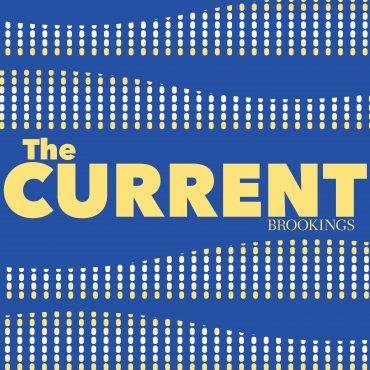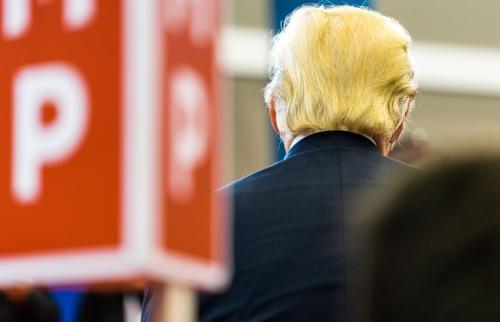President Joe Biden marked his first 100 days in office with a “conversation with America” that reflected how Biden views his presidency and the role of government in improving American’s lives. John Hudak examines how the Biden administration mobilized effective governance to meet the challenges of the COVID pandemic and the difficulties ahead for passing legislation through Congress.
- Biden’s 100-day strategy: Under-promise and over-deliver
- The first 100 days: When did we start caring about them and why do they matter?
Listen to Brookings podcasts here, on Apple or on Google podcasts, send email feedback to [email protected], and follow us at @policypodcasts on Twitter.
Thanks to audio producer Gaston Reboredo, Chris McKenna, Fred Dews, Marie Wilken, and Camilo Ramirez for their support.
TRANSCRIPT
PITA: President Biden marked his first 100 days in office with an address to a joint session of Congress, laying out a sweeping range of plans and framing his presidency as an urgent, even existential demonstration that American democracy still works, and that government can deliver for the American people.
With us to discuss President Biden’s first 100 days is John Hudak, senior fellow and deputy director, Center for Effective Public Management here at Brookings. John, thanks for coming back on the program again.
HUDAK: It’s good to be back.
PITA: John, as you look back on President Biden’s first 100 days, obviously so much of that time has been focused on the profound public health and economic crisis of the COVID pandemic. What’s your overall take what’s been accomplished so far and how the administration is taking shape?
HUDAK: Obviously, the president came to office facing enormous challenges, in many ways, probably the biggest uphill battle since FDR. What he has done is mobilized effective governance to continue what was an existing vaccination program but also expanding it dramatically, making it more logistically possible. As the president mentioned last night, 90% of Americans live within five miles of vaccination site, and that’s an incredible achievement with regard to an area of policy that one year ago we were just really starting to learn about.
And, of course, the economic effects of the pandemic have been profound and so being able to pass an additional rescue package, getting checks out to Americans and continuing to stabilize the economy has been remarkable, and as of this morning, we saw yet another increase in the GDP compared to the fourth quarter and so after 100 days it’s hard to argue anything except that the Biden presidency has been successful thus far.
PITA: Can I ask you a little bit of a meta question, sort of a process question? When you’re asked questions like this about how do you evaluate this president or that president’s first 100 days, as someone who researches these issues, researches effective governance, what sort of measuring sticks do you use, especially if you’re trying to compare one president to another?
HUDAK: Yeah, I think the hundred days metric is a bit of an outdated tool, if it really ever was in vogue. It’s something that is artificial; it’s something that President Roosevelt put into place and it’s now impossible for any president to avoid that metric. That said, there are some situations and some issues and some policies that are easier than others to achieve in 100 days. Others take more time. Simply getting something done or getting something passed within 100 days doesn’t necessarily make it inherently good or necessarily better than what an alternative could be.
That said, there are moments like the one we’re currently in where we have a lot of data after 100 days to judge what President Biden has done. You know, Biden setting his first goal of 100 million shots in arms in the first hundred days and then extending it to 200 million shots in arms in the first hundred days, that’s great. That means that people are getting vaccinated. That’s significantly important. If that took 105 days to get 200 million shots in arms, would that mean it’s a failure? No, and so I think this obsession with this metric, both presidentially, and media, and by the public, clouds what is the basic rule in American politics, and that is that Americans are going to base a president off of the job that he’s done overall and how that president has helped them. You don’t have many people after four years say, “you know I’m better off than I was four years ago, but damn, that first hundred days could have gone better.”
And so, I think, now that the first hundred days is over, we can take a deep breath and like every presidency, start to look at it from a different measure of performance metrics, and that is, how are things going overall and what trajectory is this presidency moving in?
PITA: All right. In that regard Biden’s candidacy really started as a response to Trump’s presidency and became about our response to the deepening pandemic crisis. President Biden would have been coming in with a long list of major priorities, even without COVID, many of them were internationally focused. How do you look at how the pandemic and the need for urgent action there affected what his priorities are and how he is addressing them?
HUDAK: Obviously the pandemic has been front and center for this president. Every American expects that to be the case for this president in the same way that Americans expected that to be for much of the last year of the Trump presidency. In that regard, it of course displaces the ability of a White House to do more things. What Mr. Biden has done effectively has sort of taken a step back and used the pandemic to shine a light on a variety of other areas in American life where there needs to be improvements: public health, race relations, issues like that that are intimately connected to the pandemic, even if people don’t necessarily see it at first glance. Economic inequality is another one, and so the president’s approach of saying that this is more than just about vaccinating the public, this is more than just about understanding this virus, but it’s a real opportunity to start to rebuild America and the type of policies that the government uses to serve its constituents. We’re starting slowly to see the president move on those issues but, of course, if the president came out of the gate on day one, and said, you know, the only thing I’m going to focus on is building more roads and bridges, that would have been an utter and complete failure, because the American public expected and needed the pandemic to be dealt with. And so now that we’re passing into a period in which the pandemic is obviously getting under control, and we are obviously rounding a corner, it gives the president and his administration more breathing room to deal with some of those other issues, both domestically and internationally.
PITA: Democrats have extremely narrow control in Congress. What’s your view on how the White House has managed that balance of power as it as it seeks to accomplish its goals?
HUDAK: You know, we really only have one or two major pieces of legislation that have passed this Congress, the first being that COVID relief package, the second being a COVID-related anti-hate crimes bill in response to the massive uptick in hate crimes against Asian Americans in the United States. One of those passed as narrowly as possible; the other one passed with overwhelming bipartisan support in both chambers. So, we don’t have a great track record based on legislation about how the president has dealt with those narrow majorities. All that said, it could have been quite easy for that COVID relief package to have failed. There were a lot of differences of opinion, not just across the parties, but within the Democratic Party, and still the president and congressional leadership were still able to keep the Democratic caucus in line and to pass that legislation.
Moving forward, we know that the use of reconciliation, that is the ability to pass legislation through the Senate without needing to beat a filibuster is quite limited and so that bipartisan negotiation that President Biden as a candidate prided himself on—it’s a role he took on as vice president for eight years—needs to really come into action. For the president, he has two very difficult tasks. As difficult as it will be to negotiate with congressional Republicans, who have really no interest in seeing him succeed, he also has to negotiate with the progressives in his own party who are not going to want President Biden to essentially give away the store in an effort to find bipartisan cooperation. So, the idea that simply negotiating toward the middle is going to pick up more votes fails to recognize that negotiating too far to the right is going to lose votes on the left, and so it’s a tall order for the president and it’s something we’re going to see play out, particularly over the next year.
PITA: In Wednesday night’s address, Biden spoke for an hour, he covered a lot of ground, laid out lots of upcoming priorities. What did you find to be the most important aspect of last night’s speech? What should people really be focusing on?
HUDAK: You know, I think, listening to the president talk about the American Families Plan and what he wants to see done to our economy, to the role of government, to the way that we pay for the types of policy programs that he’s interested in, and to think very clearly and in deeply about whether they support that. Public polling suggests the vast majority of Americans, including majorities of Republicans, support a lot of what the president was talking about with regard to the American Families Plan.
And that’s all obviously critically important, but at the same time, I think one of the most important or one of the most remarkable parts of last night was simply the president’s tone, a dramatic transition from the type of tone that President Trump took. And his conversation with America—at times that speech became a conversation. He didn’t talk as much about what he did, or what his administration did; he talked about what we have done, and sometimes that “we” meant all Americans, sometimes that we meant me and my administration, as well as you in Congress, and it was a demonstration of a presidency that recognizes its plural nature and not a presidency that recognizes the importance of one man. And I think that is something that a lot of Americans can look to, and even if you disagree with the president on the issues, it’s hard to disagree with the idea that, last night, the man at that lectern was presidential in nature.
PITA: All right. John, thanks so much for talking to us again today.
HUDAK: Thank you.






Commentary
PodcastHow do Biden’s first 100 days reflect his vision for America?
April 29, 2021
Listen on
The Current Podcast